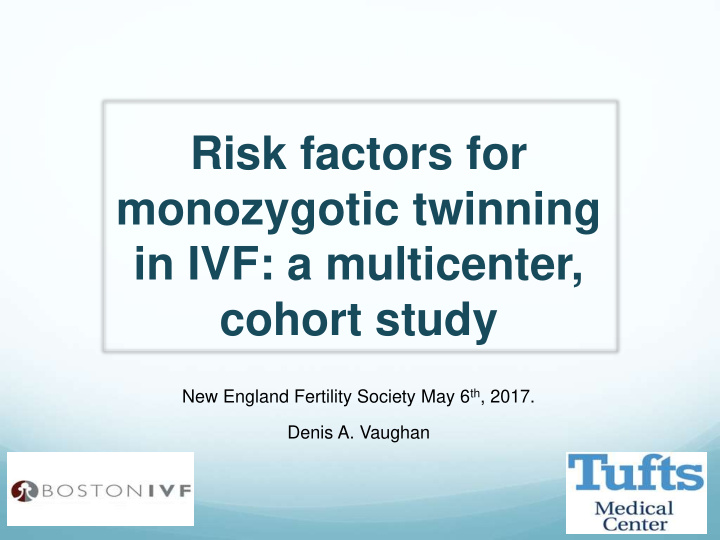



Risk factors for monozygotic twinning in IVF: a multicenter, cohort study New England Fertility Society May 6 th , 2017. Denis A. Vaughan
Disclosures Nothing to disclose
Objectives Background on monozygotic twinning (MZT) Preliminary results Future study plans Questions
Background
Background
Background Monozygotic (MZ) twins carry a significantly higher risk of perinatal morbidity and mortality than singleton and dizygotic twins 1,2 Increased risk of premature delivery 1 Growth discordance 3 Developmental anomalies 4 Mortality 1
Background Incidence of MZ twinning (MZT) is greatly increased amongst IVF patients compared to the general population (0.7-13% vs. 0.45%, respectively) Reason for this remains unclear 5,6
Background Prolonged embryo culture, appears to be a risk factor 6 Studies have also hypothesized that media characteristics — such as glucose 7 or glutathione levels — may affect MZT rates. Zona Pellucida micromanipulation may be involved Others have suggested that the high incidence of MZT in infertility patients is conditioned by hereditary factors 8
Study Objective Create a large, multicenter database to include data on monozygotic twinning in IVF To investigate risk factors for MZT
Methods Using an electronic medical record system (eIVF, PracticeHwy), clinical pregnancy data (confirmation of a gestational sac(s) and presence of a fetal pole with a heartbeat(s) on ultrasound) Data from 10 large IVF clinics in the U.S from January 1st 2000 to January 31 st 2017 were retrospectively reviewed. Both fresh and thaw cycles were included
Methods MZT: when the number of fetal poles with cardiac activity seen and recorded exceeded the number of embryos transferred A binary logistic regression was performed to ascertain risk factors for MZT within our cohort
Results >124,000 clinical pregnancies identified in the database 61,924 clinical pregnancies met criteria for modeling 50,215 pregnancies resulted from fresh transfers 11,709 pregnancies resulting from thaw transfers
Cohort characteristics (n= 61,924) Fresh Frozen Total Age at cycle start 36.14 +/- 5.04 37.48 +/- 5.8 36.39 +/- 5.2 Transfer Day 2-3 days 28240 1022 (1.7%) 29262 (47.3%) 4-7 days (45.6%) 10687 (17.3%) 32662 (52.7%) 21975 (35.5%) PGD performed 2140 (3.5%) 501 (0.8%) 2641 (4.3%) Embryos transferred 2.13 +/- 1.06 0.93 +/1.84 1.9 +/- 1.12 IVF performed 25201 0 25201 (40.7%) (40.7%) ICSI performed 28566 0 28566 (46.1%) (46.1%) Assisted hatching performed 9573 (15.5%) 0 9573 (15.5%)
Results 352 cycles (0.57%) resulted in MZ twins 198 in the fresh cycle group 154 in the thaw cycle group
Monozygotic Twin Cohort Characteristics (n=352, 0.57%) MZT Non-MZT Total Age at cycle start 35.8 +/- 5.76 36.4 +/- 5.22 36.39 +/- 5.2 Transfer Day 2-3 days 49 (0.1%) 29213 (47.2%) 29262 (47.2%) 4-7 days 303 (0.5%) 32359 (52.3%) 32662 (52.7%) PGD performed 28 (0.04%) 2613 (4.2%) 2641 (4.3%) Embryos transferred 1.25 +/- 0.7 1.91 +/1.1 1.9 +/- 1.12 Any embryo biopsy (ICSI, assisted 133 (0.2%) 30062 (48.2%) 30195 (48.8%) hatching, PDG)
Table 1. Risk Factors for MZT events among 61,920 IVF cycles from Jan 2000 through Dec 2016. Adjusted odds ratios and p-values from multivariable logistic regression.
Conclusions (Preliminary) We have validated the hypothesis that prolonged embryo culture is a major risk factor for MZT For each additional day in culture the OR for MZT increases by 1.4 Thaw cycles appear to be twice as likely to result in MZT
Future Studies Further investigate potential risk factors behind the increase in likelihood of MZT Investigate our clustering theory across all clinics independently Identify laboratory or clinical changes which may increase the risk of monozygotic clinic
References 1. Sebire NJ, Snijders RJ, Hughes K et al. The hidden mortality of monochorionic twin pregnancies. Br J Obstet Gynaecol 1997;104:1203. 2. Glinianaia SV, Obeysekera MA, Sturgiss S, Bell R. Stillbirth and neonatal mortality in monochorionic and dichorionic twins: a population based study. Hum Reprod 2011;26:2549. 3. Maier RF, Bailobreski B, Gross A, Vogel M, Dudenhausen JW, Obladen M. Acute and chronic fetal hypoxia in monochorionic and dichorionic twins. Obstet Gynecol 1995;86:973-7. 4. Honma Y, Minakami H, Eguchi Y, Uchida A, Izumi A, Sato I. Relation between hemoglobin discordance and adverse outcome in monochorionic twins. Acta Obstet Gynecol Scand 1999;78:207-11. 5. Vitthala S, Gelbaya TA, Brison DR, Fitzgerald CT, Nardo LG. The risk of monozygotic twins after assisted reproductive technology: a systematic review and meta-analysis. Hum Reprod 2009;15:45-55. 6. Knopman JM, Krey LC, Oh C, Lee J, McCaffrey C, Noyes N. What makes them split? Identifying risk factors that lead to monozygotic twins after in vitro fertilization. Fertil Steril. 2014;102(1):82-9 7 Menezo YJR, Sakkas D. Monozygotic twins: Is it related to apoptosis in the embryo? Hum Reprod 2002;17:247 – 51. 8. Sobek A Jr, Zbořilová B, Procházka M, Šilhánová E, Koutná O, Klásková E et al. High incidence of monozygotic twinning after assisted reproduction is related to genetic information, but not to assisted reproduction technology itself. Fertil Steril. 2015 Mar;103(3):756-60
Acknowledgements Boston IVF faculty and Staff Department of OBGYN at Tufts Medical Center New England Fertility Society/eIVF Irvine Scientific
Thank you
Recommend
More recommend